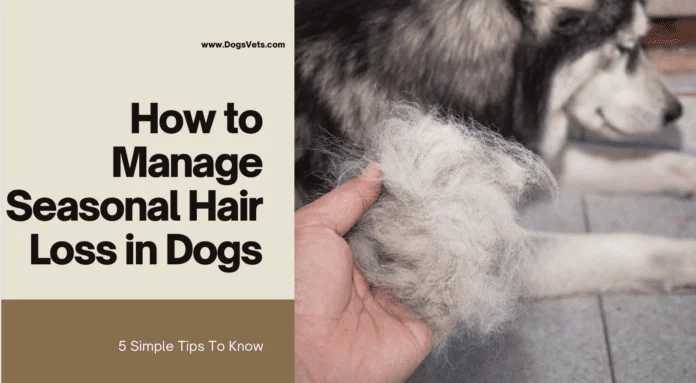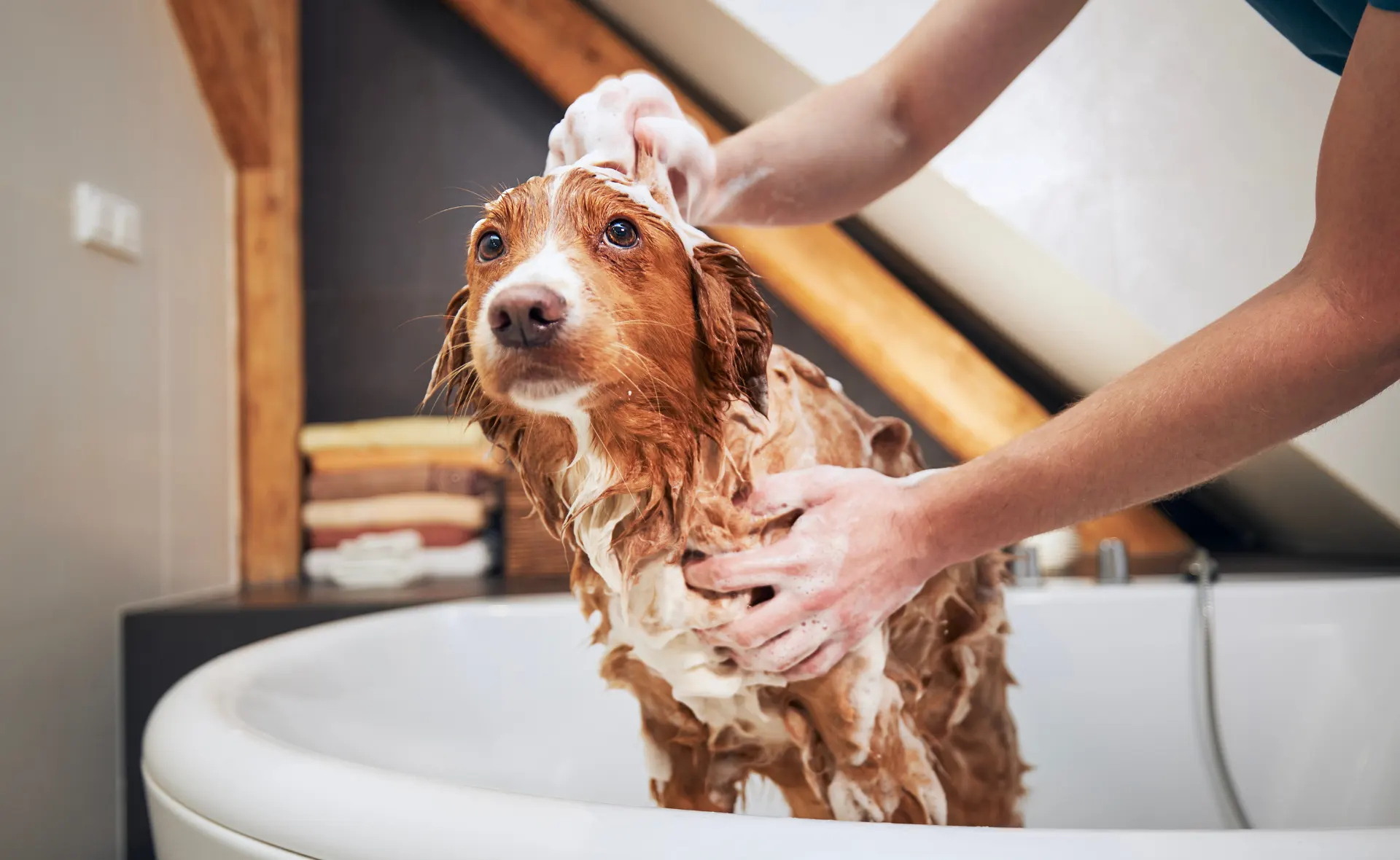Last Updated on January 31, 2024 by Dogs Vets
How to Manage Seasonal Hair Loss in Dogs
Seasonal hair loss in dogs is a prevalent issue that often raises concerns among pet owners. As the weather undergoes changes, it’s not uncommon for dogs to go through periods of excessive shedding, leading to a flurry of fur throughout your home.
Understanding the factors contributing to seasonal hair loss is crucial. Dogs, like many animals, have a natural shedding cycle influenced by daylight exposure, temperature fluctuations, and hormonal changes associated with the seasons.
While this process is entirely normal, it can be frustrating for pet owners dealing with the aftermath of shedding. Fortunately, there are practical steps you can take to manage and mitigate the impact of seasonal hair loss on your furry companion.
Regular grooming plays a pivotal role in controlling shedding. Brushing your dog’s coat helps remove loose fur, preventing it from accumulating on furniture and floors. Additionally, it promotes a healthier coat by distributing natural oils and preventing matting.
Choosing an appropriate diet is another essential aspect. Providing a well-balanced and nutrient-rich diet supports your dog’s overall health, including the condition of their skin and coat.
Omega-3 fatty acids, often found in fish oil supplements, can contribute to a shinier and healthier coat while potentially reducing excessive shedding.
Understanding Seasonal Hair Loss
Seasonal hair loss, also known as shedding, is a natural process for dogs. It typically occurs during the spring and fall when the weather changes. Dogs shed their old fur to make way for new growth, adapting to the temperature variations and preparing for the upcoming season.
While shedding is a normal occurrence, some dogs may experience excessive hair loss, which can be attributed to various factors such as breed, genetics, diet, and overall health.
It’s important to differentiate between normal shedding and excessive hair loss to determine the appropriate management strategies.
Managing Seasonal Hair Loss
1. Regular Brushing: Brushing your dog’s coat regularly helps to remove loose fur and prevents it from accumulating in your home. Use a brush suitable for your dog’s coat type and be gentle to avoid causing any discomfort.
2. Balanced Diet: Providing your dog with a balanced and nutritious diet is crucial for maintaining healthy skin and coat. Consult with your veterinarian to ensure your dog’s diet includes essential nutrients like omega-3 fatty acids, which promote coat health.
3. Proper Hygiene: Regular bathing and grooming are essential for maintaining a healthy coat. Use a mild shampoo formulated for dogs and avoid over-bathing, as it can strip the coat of its natural oils, leading to dryness and increased shedding.
4. Supplements: In some cases, your veterinarian may recommend supplements to support coat health. Omega-3 fatty acid supplements, for example, can help reduce inflammation and promote a healthy coat.
5. Environmental Control: Creating a comfortable environment for your dog can help minimize seasonal hair loss. Ensure your home is well-ventilated and maintain a consistent temperature to prevent excessive shedding.
While some shedding is normal, seasonal hair loss in dogs can be more dramatic than usual. Luckily, there are several ways to manage it and keep your furry friend comfortable:
Brushing:
- This is the single most important step. Regular brushing removes loose hair, stimulates the coat, and improves blood circulation.
- Choose the right brush for your dog’s coat type:
- Short-haired dogs: Mitt or glove, pin and bristle brush
- Long-haired and double-coated dogs: Slicker brush, de-shedding tool
- Brush daily during shedding season, and at least once a week during other times.
Diet:
- A healthy diet rich in protein and omega-3 fatty acids nourishes the skin and hair from within.
- Look for high-quality food with protein as the first ingredient.
- Consider adding omega-3 supplements like fish oil for extra moisture and anti-inflammatory benefits.
- Ensure your dog stays hydrated with plenty of fresh water.
Supplements:
- Melatonin supplements can be helpful for dogs with flank alopecia, a common type of seasonal hair loss.
- Consult your veterinarian for the appropriate dosage and duration of treatment.
- Other supplements like vitamin A and biotin can also contribute to a healthy coat.
Additional Tips:
- Provide ample sunlight during the day, especially in fall and winter, to regulate their melatonin production.
- Manage stress, as it can worsen shedding. Regular exercise and playtime can help.
- Keep the house cool and humid to avoid dry skin and flaking.
- Avoid harsh shampoos and soaps, which can strip the coat of its natural oils.
- Consult your veterinarian if the hair loss is accompanied by other symptoms like redness, itching, or scratching.
Remember, some breeds shed more than others, and seasonal variations are a natural part of their cycle. However, by following these tips, you can minimize the shedding and keep your dog’s coat healthy and beautiful.
Frequently Asked Questions
1. How do I stop my dog from shedding so much?
To reduce excessive shedding, establish a regular grooming routine, provide a balanced diet, and ensure your dog’s overall health is in check. Regular brushing and bathing can also help manage shedding.
2. Why is my dog shedding so much hair?
Seasonal shedding is a natural process for dogs. However, excessive shedding could be a sign of an underlying issue such as allergies, hormonal imbalances, or skin infections. If you’re concerned about your dog’s excessive shedding, it’s best to consult with a veterinarian.
3. What can I feed my dog to stop shedding?
A well-balanced diet that includes essential nutrients like omega-3 fatty acids can help promote a healthy coat and reduce shedding. Consult with your veterinarian to determine the best diet for your dog’s specific needs.
4. How to deal with excessive dog shedding?
If your dog is experiencing excessive shedding, it’s important to identify the underlying cause. Consult with a veterinarian to rule out any underlying health issues and follow their recommendations for managing and reducing shedding.
5. Can certain breeds shed more than others?
Yes, certain dog breeds are known to shed more than others. Breeds such as Labrador Retrievers, German Shepherds, and Siberian Huskies have double coats and tend to shed more. Regular grooming and maintenance can help manage shedding in these breeds.
6. How often should I brush my dog’s coat?
The frequency of brushing depends on your dog’s coat type. Dogs with longer or thicker coats may require daily brushing, while dogs with shorter coats may need brushing a few times a week. Consult with a professional groomer or veterinarian for guidance specific to your dog’s coat.
7. Are there any specific products to reduce shedding?
There are various grooming products available that claim to reduce shedding. However, it’s important to be cautious and choose products that are safe for your dog’s skin and coat. Consult with a veterinarian before using any specific products to manage shedding.
By following these tips and implementing a proper care routine, you can effectively manage seasonal hair loss in your dog.
Remember that each dog is unique, and it’s essential to consult with a veterinarian for personalized advice and guidance.
Sources:
– American Kennel Club: www.akc.org
– The Spruce Pets: www.thesprucepets.com
– PetMD: www.petmd.com
Fact Check
We hope you enjoyed reading this article. What are your thoughts on the topic?
“At [Dogsvets.com], our goal is to bring you the most accurate and up-to-date information on all things pet-related.
If you have any additional insights or would like to advertise with us, don’t hesitate to get in touch.
If you notice any errors or discrepancies in our content, please let us know so we can correct them. We welcome your feedback and encourage you to share this article with others.”

















